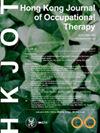Stigma and the use of umbrellas, hiking poles and walking sticks to aid walking in Hong Kong
IF 0.8
4区 医学
Q4 REHABILITATION
引用次数: 0
Abstract
Background The use of walking aids is widely acknowledged as one of the most relied-on forms of assistive technology. Using stick-shaped devices, such as a cane, is often the entrance for many people to the world of assistive technologies, often accompanied by the negative stigma associated with ageing and disability. Objectives This study investigated the perception of disability and needs of the Hong Kong population using walking aids, aiming to inform device design and service provision. Methods We observed 391 individuals using cane-like devices in their natural environment and conducted semi-structured interviews with 28 participants to understand stigma, barriers to acquisition, training, and design requirements. Results Half of the interviewees (50%, n = 14) did not feel disabled when using a walking stick, while 39% felt slightly disabled. 56% of the observed sample used non-medical-looking aids like hiking poles or umbrellas. Most interviewees (79%) purchased off-the-shelf devices, but less than half received seller support in choosing appropriate aids. Conclusion The feelings associated with using walking sticks and similar devices are mostly positive. There is a preference in Hong Kong for using devices without a medical appearance to aid walking, such as umbrellas and hiking poles. There is a need to raise awareness of the risks of using umbrellas to aid walking and empower the user to make informed decisions when purchasing walking aid devices. In addition, there is a need to support the supply chain of walking aids, including umbrellas and hiking poles, to provide more information on device use, misuse, training, and maintenance.耻辱感与香港人使用雨伞、登山杖和手杖辅助行走的情况
背景 步行辅助工具的使用被公认为是最可靠的辅助技术之一。使用拐杖等棍状装置往往是许多人进入辅助技术世界的第一步,同时往往伴随着与老龄化和残疾相关的负面污名。本研究调查了香港使用助行器的人群对残疾的看法和需求,旨在为助行器的设计和服务提供参考。方法 我们观察了 391 名在自然环境中使用手杖类辅助器具的人,并对 28 名参与者进行了半结构式访谈,以了解他们的耻辱感、购买障碍、培训和设计要求。结果 半数受访者(50%,n = 14)在使用手杖时不觉得自己是残疾人,39%的受访者觉得自己有轻微残疾。56%的受访者使用非医疗外观的辅助工具,如登山杖或雨伞。大多数受访者(79%)购买了现成的辅助器具,但只有不到一半的受访者在选择合适的辅助器具时得到了销售商的支持。结论 使用手杖和类似器具的感受大多是积极的。在香港,人们更倾向于使用没有医疗外观的辅助行走装置,如雨伞和登山杖。有必要提高人们对使用雨伞辅助行走的风险的认识,并让使用者在购买辅助行走装置时做出明智的决定。此外,还需要支持包括雨伞和登山杖在内的助行器供应链,提供更多关于助行器使用、误用、培训和维护的信息。
本文章由计算机程序翻译,如有差异,请以英文原文为准。
求助全文
约1分钟内获得全文
求助全文
来源期刊
CiteScore
1.10
自引率
0.00%
发文量
18
审稿时长
>12 weeks
期刊介绍:
The Hong Kong Journal of Occupational Therapy is the official peer-reviewed open access publication of the Hong Kong Occupational Therapy Association. The Journal aims to promote the development of theory and practice in occupational therapy (OT), and facilitate documentation and communication among educators, researchers and practitioners. It also works to advance availability, use, support and excellence of OT and maintain professional standards to promote better understanding of OT.

 求助内容:
求助内容: 应助结果提醒方式:
应助结果提醒方式:


